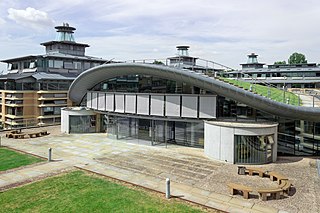Related Research Articles

J. Lamar Worzel was an American geophysicist known for his important contributions to underwater acoustics, underwater photography, and gravity measurements at sea.
The Slade Professorship of Fine Art is the oldest professorship of art and art history at the universities of Cambridge, Oxford and University College, London.

The Department of Earth Sciences at Cambridge is the University of Cambridge's Earth Sciences department. First formed around 1731, the department incorporates the Sedgwick Museum of Earth Sciences.
Dan Peter McKenzie is a Professor of Geophysics at the University of Cambridge, and one-time head of the Bullard Laboratories of the Cambridge Department of Earth Sciences. He wrote the first paper defining the mathematical principles of plate tectonics on a sphere, and his early work on mantle convection created the modern discussion of planetary interiors.

The Faculty of Mathematics at the University of Cambridge comprises the Department of Pure Mathematics and Mathematical Statistics (DPMMS) and the Department of Applied Mathematics and Theoretical Physics (DAMTP). It is housed in the Centre for Mathematical Sciences site in West Cambridge, alongside the Isaac Newton Institute. Many distinguished mathematicians have been members of the faculty.
Sir Edward Crisp Bullard FRS was a British geophysicist who is considered, along with Maurice Ewing, to have founded the discipline of marine geophysics. He developed the theory of the geodynamo, pioneered the use of seismology to study the sea floor, measured geothermal heat flow through the ocean crust, and found new evidence for the theory of continental drift.
Herbert Eric Huppert is a British geophysicist. He has been Professor of Theoretical Geophysics and Foundation Director, Institute of Theoretical Geophysics, at the University of Cambridge, since 1989 and Fellow of King's College, Cambridge, since 1970.
Maurice Neville Hill FRS was a British marine geophysicist.

Edward A. "Ted" Irving, was a British-Canadian geologist. He was a scientist with the Geological Survey of Canada. His studies of paleomagnetism provided the first physical evidence of the theory of continental drift. His efforts contributed to our understanding of how mountain ranges, climate, and life have changed over the past millions of years.
The William Bowie Medal is awarded annually by the American Geophysical Union for "outstanding contributions to fundamental geophysics and for unselfish cooperation in research". The award is the highest honor given by the AGU and is named in honor of William Bowie, one of the co-founders of the Union.
James Anthony Jackson CBE FRS is Emeritus Professor of Active Tectonics and formerly head of Bullard Laboratories, and Head of the Department of Earth Sciences, Cambridge University. He made his name in geophysics, using earthquake source seismology to examine how continents are deformed. His central research focus is to observe the active processes shaping our continents.

Michael Selwyn Longuet-Higgins FRS was a British mathematician and oceanographer at the Department of Applied Mathematics and Theoretical Physics (DAMTP), Cambridge University, England and Institute for Nonlinear Science, University of California, San Diego, USA. He was the younger brother of H. Christopher Longuet-Higgins.
The Vetlesen Prize is a prize in geology awarded jointly by Columbia University's Lamont–Doherty Earth Observatory and the G. Unger Vetlesen Foundation. The prize is generally regarded as the highest distinction in geologic studies, and the "Nobel Prize for geology".
Sir Alan Hugh Cook FRS was an English physicist who specialised in geophysics and metrology. He worked at the University of Cambridge, National Physical Laboratory, and the University of Edinburgh. From 1977-79 Cook was President of the Royal Astronomical Society.
Kanthia Kunaratnam was a Sri Lankan Tamil physicist, academic and former vice-chancellor of the University of Jaffna.

Kathryn Anne "Kathy" Whaler OBE FRSE FAGU is a professor of geophysics at the University of Edinburgh School of GeoSciences, in the Research Institute of Earth and Planetary Science and is a member of the Solid Earth Geophysics and Natural Hazards Research Group.

SirGerald Ponsonby Lenox-Conyngham was an Irish surveyor and geodesist. He was the last superintendent of the Great Trigonometrical Survey from 1912 to 1921, and was reader in geodesy at the University of Cambridge from 1922 to 1947.

The Faculty of English is a constituent part of the University of Cambridge. It was founded in 1914 as a Tripos within the Faculty of Medieval and Modern Languages. It could be studied only as a 'Part I' of a degree course, alongside a 'Part II' either in medieval languages or from another Tripos. In 1926, the course became a distinct Faculty.
The Professorship of Mineralogy and Petrology is a statutory professorship at the University of Cambridge. It was created in 1931 following the simultaneous retirements of Alfred Harker, from the post of Reader in Petrology in the Department of Geology, Cambridge; and of Arthur Hutchinson, Professor of Mineralogy. A committee of the Council of the Senate of the university proposed that these two posts be discontinued, and the remit of the Professorship of Mineralogy be expanded to include the disciplines of petrology and crystallography. The Professorship was established in the newly created Department of Mineralogy and Petrology. The first incumbent was Prof Cecil Edgar Tilley, who was appointed in 1931. Tilley was succeeded in 1961 by William Alexander Deer. Since 1980, and following the appointment of Ron Oxburgh, the Professorship has been associated with the Department of Earth Sciences, Cambridge. The other statutory professorships in this department are the Woodwardian Professor of Geology, the Professor of Geophysics, established in 1966, and the recently endowed BP Foundation McKenzie Professorship of Earth Sciences, established in 2010.
John Arthur “Jack” Jacobs was a British geophysicist and mathematician, whose primary area of research was geomagnetism. He worked at multiple universities in Canada and the UK, and was awarded the Gold medal of the Royal Astronomical Society in 2002.
References
- ↑ "Professors". Cambridge University. Retrieved 28 October 2024.
- ↑ Williams, Carol (2010), Madingley Rise and Early Geophysics at Cambridge, Third Millennium Pub Ltd , ISBN 190650718X